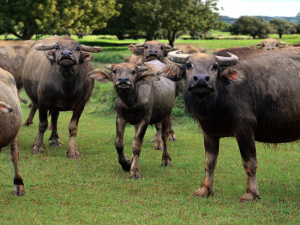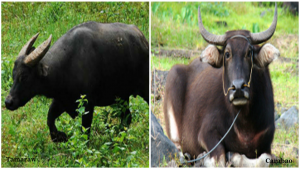
QUEZON City, Philippines (October 2) – The Philippines is known for its abundant land, enthusiastic people, and wide variety of animals. Due to its rich culture, it produced many symbolic connotations that are connected with fruits, animals and things. One of said symbolic connotations is the Tamaraw that, unfortunately, has been taken for granted by many Filipinos.
Bubalus mindorensisis the scientific name of this buffalo from Mindoro. It is often mistaken with our national animal; the Carabao, for they are both similar in body structure. Aside from that, they are both very different creatures. The Tamaraw has a V-shaped horn that is shorter than the Carabao’s. It looks flat and straight, while the horns of the Carabao are curved and longer. Tamaraws are also shorter in height and weighs lighter for it stands about 4 feet and weighs 300 kilograms. Carabaos on the other hand, stand 4.5 feet and weighs from 500 to 700 kilograms. In terms of behavior, Tamaraws tend to get aggressive when threatened by people and often shy way in the presence of humans. Carabaos are subservient in nature for they are used in farming and plowing fields and transportation of goods. The huge difference between the two is that the Carabaos are domesticated, and the Tamaraws are endangered. Because of cattle ranching, hunting diseases and land conversion, their population had dramatically decreased. In fact,  as of 2007, the IUCN or the International Union for Conservation of Nature listed it as Critically Endangered(CR) because they are on the verge of extinction. That is why the government took precautionary measures in order to preserve the said species. They are protected by the Philippine law; specifically, Commonwealth Act 73 and Republic Acts 1086, 7586 and 9147. These acts prohibit hunting, poaching and harming the Tamaraws. The Department of Environment and Natural Resources (DENR) on the other hand, held activities to increase public awareness about these animals and their current situation. Recently, “Takbo para sa Tamaraw” was conducted in partnership with Far Eastern University to raise public consciousness about the animal. It is said that over 600 people participated in the fun run. Certain facilities such as the Mindoro Biodiversity Conservation, Research and Education Center were built to breed and increase the population of the Tamaraws. In fact, the Iglit-Baco National Park has the biggest population of Tamaraws that can be found in the grasslands according to Yasmin Caparas of DENR. Due to the unified actions, the population of the Tamaraws increased to 382 heads this year.
as of 2007, the IUCN or the International Union for Conservation of Nature listed it as Critically Endangered(CR) because they are on the verge of extinction. That is why the government took precautionary measures in order to preserve the said species. They are protected by the Philippine law; specifically, Commonwealth Act 73 and Republic Acts 1086, 7586 and 9147. These acts prohibit hunting, poaching and harming the Tamaraws. The Department of Environment and Natural Resources (DENR) on the other hand, held activities to increase public awareness about these animals and their current situation. Recently, “Takbo para sa Tamaraw” was conducted in partnership with Far Eastern University to raise public consciousness about the animal. It is said that over 600 people participated in the fun run. Certain facilities such as the Mindoro Biodiversity Conservation, Research and Education Center were built to breed and increase the population of the Tamaraws. In fact, the Iglit-Baco National Park has the biggest population of Tamaraws that can be found in the grasslands according to Yasmin Caparas of DENR. Due to the unified actions, the population of the Tamaraws increased to 382 heads this year.

In the words of Jose Angelito Palma, the President and Chief Executive Officer of World Wide Fund for Nature – Philippines, “by saving the tamaraw, we shall save ourselves”. We are the stewards of this nation and it is our duty to protect the wildlife and the lands from which they are residing. The Tamaraw is one of our national treasures that must be preserved for the future generations to see. It is like a gem that is rare and beautiful, tempting to touch but forbidden to take. Let us all help the government to continue their endeavors to restore the usual glory of this noble animal.
Sources:
http://www.denr.gov.ph/news-and-features/features/1075-conserving-the-tamaraw-conserving-our-heritage.html
http://www.arkive.org/tamaraw/bubalus-mindorensis/
http://www.rappler.com/science-nature/41173-tamaraw-carabao
www.feu.edu.ph
(written by Carissa Lazaro, edited by Jay Paul Carlos, additional research by Lovely Ann Cruz)







